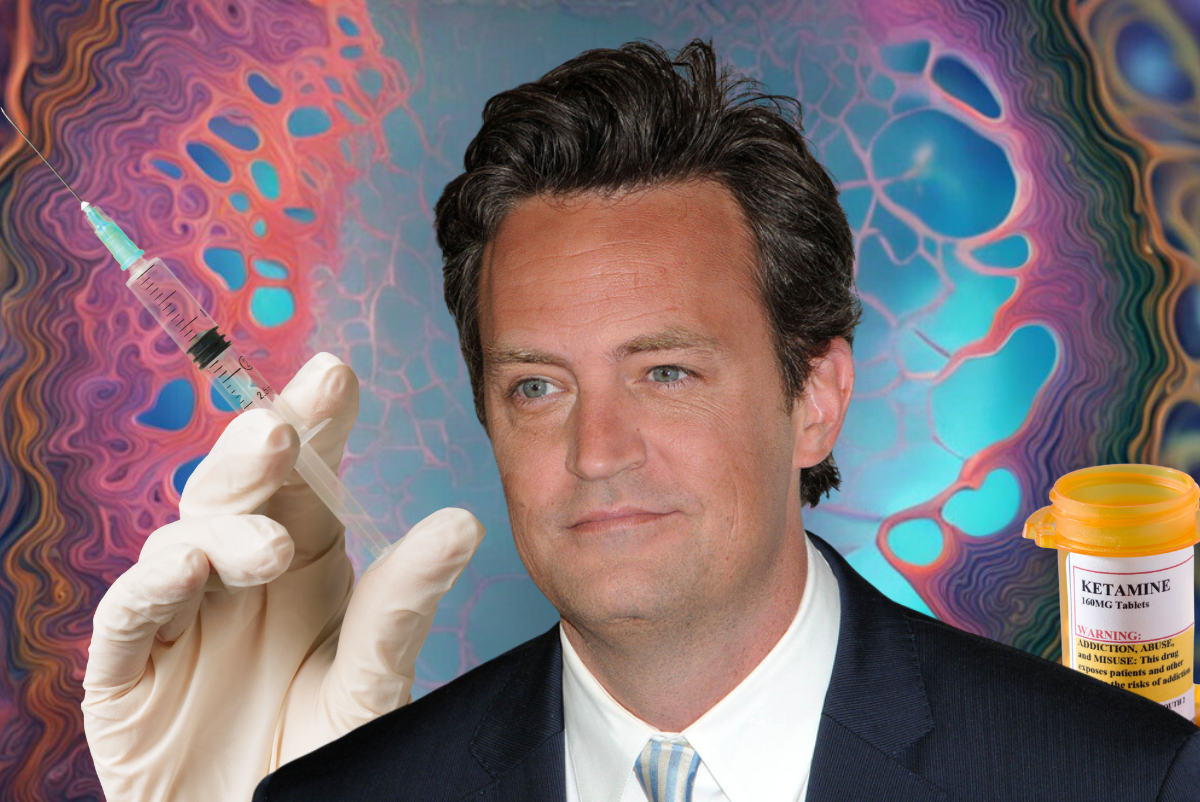
Last Friday, the Los Angeles Medical Examiner’s Office released the autopsy report associated with Matthew Perry, star of the 90’s sitcom, “Friends,” who was tragically found dead in his Pacific Palisades pool on October 28.
According to the report, it was determined that Perry’s cause of death was a result of “acute effects of ketamine” and subsequent drowning with levels of 3271-3540 ng/ml of ketamine present in his system at or around the time of death.
Because of his status as a Hollywood celebrity, much of Perry’s personal life, including his long-standing battle with substance abuse and depression have been made extremely public since he came to fame in the 1990’s while playing the role of Chandler Bing on the hit sitcom, Friends.
Recent reports also indicate that Perry had been utilizing ketamine therapy through infusions with his last session reportedly happening a week before his death.
For those who have been closely following the psychedelic therapy movement over the last several years, the concept of ketamine infusion therapy or ketamine assisted therapy is nothing new. In fact, it has become a widely accepted and utilized treatment option for individuals suffering from a myriad of mental and physical health conditions such as treatment-resistant depression, anxiety, and chronic pain and has in most cases has demonstrated more effective levels of efficacy when compared to “traditional” drugs and treatments like SSRI’s.
Nonetheless, as the news surrounding Perry’s cause of death spread across social media this past weekend, so too did waves of misinformed, speculative-driven comments about ketamine and in the process bringing to light the stigma that is still very much tied to ketamine and other psychedelic drugs that are being used exclusively for therapeutic purposes.
Understandably, this has raised concern amongst several professionals and physicians who have worked tirelessly to practice and administer safe and responsible ketamine assisted therapy for their patients over the last several years and who have, in many instances, helped a good number of them experience long-lasting, life changing breakthroughs with the aid of this therapeutic option and particularly in combination with some type of psychotherapy.
Dr. Steven L. Mandel, President and Founder of Ketamine Clinics Los Angeles, a leading ketamine infusion therapy clinic in Southern California, explained that, “[Perry’s autopsy report] alarms a lot of people seeking treatment with this amazingly effective, safe, fast drug.”
He continues with “What happened to Mr. Perry has nothing whatsoever to do with the treatment of mood disorders with ketamine, more than an unfortunate person who downs a fifth of vodka and suffers alcohol poisoning has anything to do with someone having a cocktail.”
With over 40 years of experience utilizing ketamine as a board-certified anesthesiologist, Dr. Mandel has safely and responsibly leveraged the benefits of ketamine infusion therapy to successfully treat thousands of patients suffering with mental health disorders and chronic pain through Ketamine Clinics Los Angeles (“KCLA”) which he founded alongside Sam Mandel, CEO of KCLA.
Sam Mandel told Psychedelic Spotlight that “In addition to the quantity of the ketamine that was involved in this case, it was also in combination with an opioid and benzodiazepine, both powerful sedatives that are dangerous, when combined just the two of them without ketamine, let alone with the addition of ketamine and alone in a hot tub. It’s quite clear that he [Perry] died by drowning, and there were all of these various factors that were contributing factors. But it wasn’t necessarily any one of them that was the real cause of death, including the ketamine, despite the fact that it was an extraordinary amount for someone to be taking by themselves in an unsupervised manner.”
Further complicating this tragic situation was the news of Perry having received ketamine infusion therapy one week before his passing, leading some on social media to speculate whether it may have had a direct correlation with his death on October 28th.
But Dr. Steven Mandel explains that “the ketamine that Matthew [Perry] received the week before has nothing whatsoever to do with his passing. Zero. And in fact ketamine stays in the system between 2 and 3 hours.”
He further highlights that while he is admittedly not an expert on Mr. Perry’s health situation at the time leading up to his death, based on reports that have been made public, where Mr. Perry was reportedly alone in a hot tub taking anesthetic levels of medicines which is the likely cause of his drowning.
Sam Mandel expressed that he is troubled by the mention in the coroner’s report of Perry’s ketamine infusion therapy session a week before his passing saying that even though it goes on to mention that there is no real correlation between the two, the mention of it has raised a lot of concern about it and leaving many to question whether there is in fact some sort of connection there.
He goes on to explain that “It’s just not possible. Yet it hasn’t kept people from becoming alarmed at what it might mean for their health and safety to have ketamine infusions.”
Indeed, what has become quite evident, and though it shouldn’t come as a surprise to anyone, is that ketamine, much like any other drug out there, legal or otherwise, can in fact be deadly in worst case scenarios when abused and not used under careful supervision.
However, much of the frustration that is being shared across the psychedelic therapy community right now is with the fact that despite there being thousands of inspiring stories of individuals whose lives have been dramatically altered for the better in some way through ketamine assisted therapy, the one story and incident, as tragic as it is, that the media is choosing to place in the spotlight is with ketamine being attributed to Perry’s passing.
If nothing else, it underscores the old adage of “if it bleeds, it leads” mentality in the world of media, and that psychedelics like ketamine still have a long way to go towards shedding decades old stigmas such as those of it being perceived as nothing more than a dangerous recreational party drug.
A slightly similar, yet very different, scenario unfolded earlier this year when the story of an Alaska Airlines pilot went viral after he attempted to shut off the engines of a plane mid-flight and placed the blame on having taken magic mushrooms two days before the flight.
As what we have seen transpire here in the wake of Perry’s autopsy report, the media, and a fair portion of social media enthusiasts are quick to jump on any story that can be sensationalized even if important facts and information are either ignored or left out.
Nevertheless, Sam Mandel shared an important sentiment which serves as a reminder of the much bigger picture surrounding ketamine infusion therapy in his remarks that “I hope that people can understand some of the nuances of how valuable this treatment is and how badly it is needed today. How badly we need real solutions for the mental health crisis, and that we are not unfairly demonizing it when it’s not used responsibly and there’s a bad outcome.”
To watch Psychedelic Spotlight‘s full interview with Dr. Steven Mandel and Sam Mandel, please click below.







